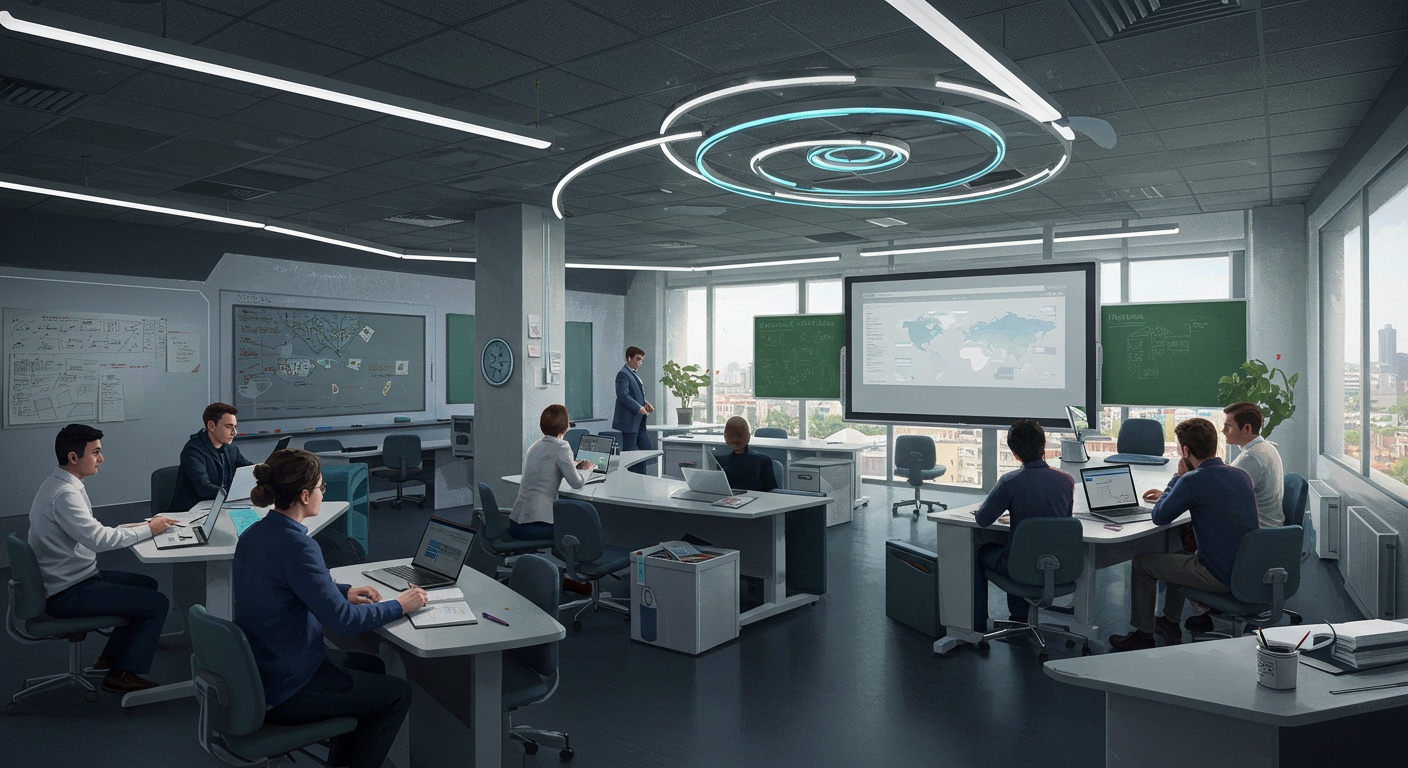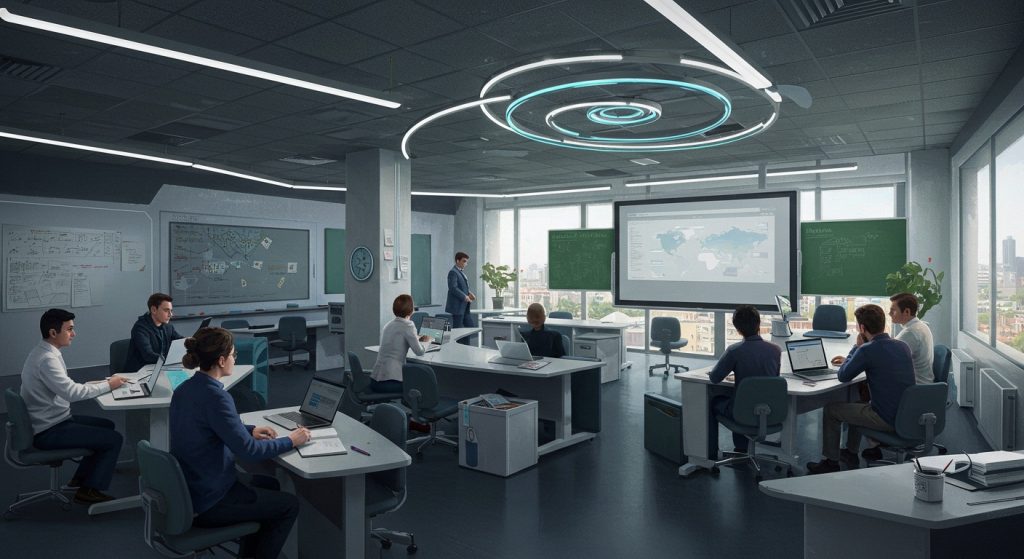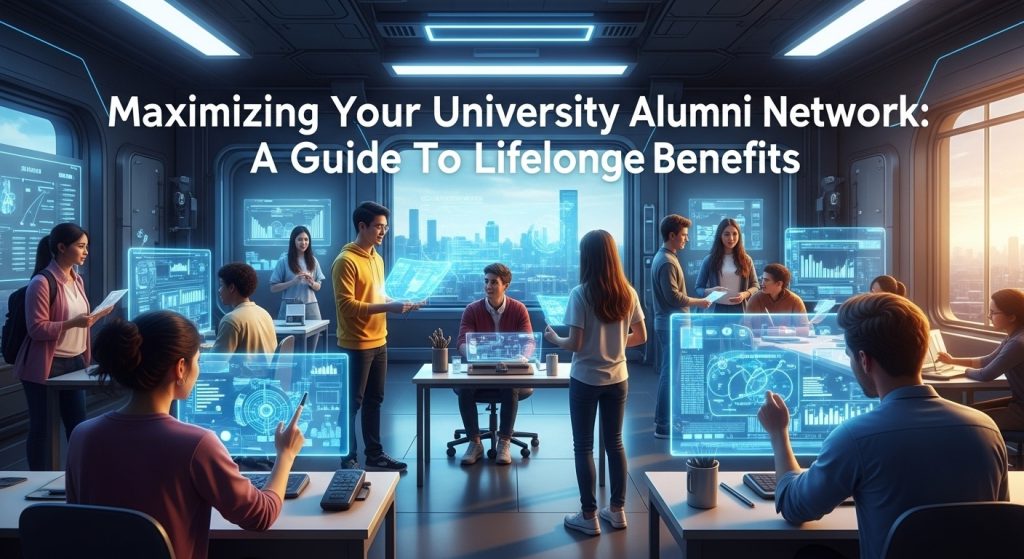The relentless pace of technological disruption, exemplified by the proliferation of generative AI and the accelerating green transition, fundamentally reshapes global industry, demanding a workforce with continuously evolving skills. Universities globally face the imperative to dramatically transform their pedagogical models and curricula, actively addressing this widening skills gap. Institutions now forge strategic alliances with industry giants like Google and Siemens, co-creating specialized programs and micro-credentials that directly embed real-world competencies. Leading institutions increasingly deploy agile curriculum development, integrating project-based learning and immersive co-op experiences to ensure graduates possess not only theoretical knowledge but also the critical adaptive capabilities employers urgently seek. This proactive evolution reflects how universities adapt to industry changes, ensuring future graduates remain competitive.

The Shifting Sands of the Job Market: Why Adaptation is Crucial
The global economy is undergoing unprecedented transformation, driven by rapid technological advancements, evolving consumer behaviors. Increasing globalization. Industries that were once stable now face disruption. New sectors emerge with astonishing speed. This dynamic environment has a profound impact on the job market, creating a significant “skills gap” – a disparity between the skills employers need and the skills job seekers possess. Automation, artificial intelligence (AI), data science. Advanced robotics are not just buzzwords; they are fundamentally reshaping roles and requiring a workforce with a different set of competencies. In this landscape, the traditional model of education, often criticized for being too slow to react, faces an imperative to evolve. Understanding how universities adapt to industry changes is no longer a luxury but a necessity for their relevance and for equipping future generations with the tools they need to thrive.
Redefining the Curriculum: From Theory to Applied Skills
One of the most significant ways universities are adapting is by fundamentally rethinking their curriculum. The focus is shifting from purely theoretical knowledge to a blend that heavily emphasizes applied skills, critical thinking. Problem-solving. This means moving beyond rote memorization and towards a more interdisciplinary and experiential approach.
- Interdisciplinary Programs: Many universities are breaking down traditional departmental silos to create programs that combine elements from different fields. For instance, a “Digital Humanities” program might merge computer science with literature, or a “Bioinformatics” degree could blend biology, computer science. Statistics. This reflects the real-world complexity where problems rarely fit neatly into one academic discipline.
- Embedding Emerging Technologies: Courses in AI, machine learning, cybersecurity, blockchain. Big data analytics are no longer confined to computer science departments. They are being integrated into business, healthcare, law. Even arts programs, acknowledging that these technologies will impact nearly every profession. For example, a business school might offer a course on “AI in Marketing Analytics.”
- Project-Based Learning (PBL): PBL is becoming a cornerstone of modern curricula. Instead of just lectures and exams, students work on real-world problems or simulated industry challenges. A typical example might be a group of engineering students designing a sustainable urban transport system for a local city council, or business students developing a market entry strategy for a new product. This directly addresses how universities adapt to industry changes by providing practical, hands-on experience.
- Micro-credentials and Stackable Degrees: Recognizing the need for lifelong learning and specialized skills, some universities are offering shorter, focused courses or certifications (micro-credentials) that can be “stacked” together to eventually form a full degree. This offers flexibility for working professionals and allows individuals to quickly acquire specific, in-demand skills.
Embracing Experiential Learning: Bridging Classroom and Workplace
While a revised curriculum is vital, true future-proofing requires more than just updated course content. Universities are increasingly emphasizing experiential learning, providing students with direct exposure to professional environments and challenges.
- Internships and Co-op Programs: These remain paramount. Universities are forging stronger ties with businesses to ensure a steady supply of relevant internship opportunities. Co-op programs, which integrate academic study with practical work experience (often full-time for a semester or more), are particularly effective. For example, Northeastern University in the US has a renowned co-op program where students alternate between periods of study and professional work experience, often leading to full-time job offers upon graduation.
- Industry-Sponsored Projects and Capstones: Many programs now culminate in a capstone project where students work directly with an industry partner on a specific problem. This gives students invaluable experience working under real constraints, deadlines. Client expectations. For instance, a group of computer science students might develop a new software feature for a tech company, or a design team might rebrand a local non-profit organization.
- Simulations and Virtual Labs: For fields where real-world exposure is difficult or dangerous (e. G. , healthcare, engineering), universities are investing in high-fidelity simulations and virtual reality (VR) labs. Medical students can practice complex surgeries in a VR environment. Engineering students can test designs in simulated conditions, providing a safe space to learn from mistakes before entering a live environment.
Strengthening Industry-Academia Partnerships: A Collaborative Approach
A crucial element in understanding how universities adapt to industry changes is the deepening of partnerships between academia and the corporate world. This collaboration is a two-way street, benefiting both students and the industries they will eventually join.
- Advisory Boards: Many university departments and programs now have industry advisory boards composed of leaders from relevant sectors. These boards provide direct input on curriculum development, ensuring that what is taught aligns with current and future industry needs. Their insights are invaluable for keeping programs relevant.
- Joint Research Initiatives: Universities and companies are increasingly collaborating on research projects. Companies bring real-world problems and funding, while universities offer cutting-edge research capabilities and academic expertise. This leads to innovations that can benefit society and creates opportunities for students to work on impactful projects. For example, a university engineering department might partner with an automotive manufacturer to research new battery technologies.
- Guest Lecturers and Mentorships: Bringing industry professionals into the classroom as guest lecturers or adjunct faculty provides students with direct insights into current practices and challenges. Also, formal mentorship programs connect students with experienced professionals, offering guidance and networking opportunities.
- Talent Pipeline Development: Companies often engage with universities to identify and nurture future talent. This can involve sponsoring scholarships, hosting career fairs, or establishing dedicated recruitment programs. This proactive approach helps universities interpret specific hiring needs and tailor their output accordingly.
Leveraging Technology for Enhanced Education
Technology is not just a subject to be taught; it’s a powerful tool being used to revolutionize how education is delivered and experienced. This is a critical area for how universities adapt to industry changes.
| Feature | Traditional Approach | Modern Tech-Enhanced Approach | Benefit |
|---|---|---|---|
| Learning Delivery | Primarily in-person lectures, fixed schedules. | Blended learning, MOOCs (Massive Open Online Courses), online degrees, flexible schedules. | Increased accessibility, flexibility. Scalability; caters to diverse learning styles. |
| Personalization | One-size-fits-all curriculum. | AI-powered adaptive learning platforms, personalized learning paths based on student performance. | Tailored content delivery, addressing individual strengths and weaknesses, improving engagement. |
| Immersive Learning | Textbooks, static images, limited lab access. | Virtual Reality (VR) and Augmented Reality (AR) for simulations, virtual field trips, interactive 3D models. | Deeper understanding, hands-on experience in a safe environment, increased retention. |
| Data Analytics | Limited data on student engagement and learning patterns. | Learning analytics platforms tracking student progress, identifying at-risk students, optimizing course content. | Proactive student support, data-driven curriculum improvements, better resource allocation. |
The use of learning management systems (LMS) like Canvas or Moodle is now standard, facilitating communication, assignment submission. Resource sharing. Moreover, universities are exploring AI tutors, automated grading systems. Blockchain for secure credentialing.
Fostering Soft Skills and Lifelong Learning
While technical skills are crucial, industry leaders consistently emphasize the importance of “soft skills” – the human competencies that enable effective collaboration and adaptation. Universities are increasingly integrating the development of these skills into their programs.
- Communication and Teamwork: Project-based learning inherently fosters teamwork and communication as students must collaborate to solve complex problems. Presentations, group discussions. Peer feedback are often built into course structures.
- Critical Thinking and Problem-Solving: Instead of just providing answers, educators are posing complex, ambiguous problems that require students to examine, synthesize data. Develop innovative solutions.
- Adaptability and Resilience: The rapidly changing world demands individuals who can quickly learn new things and bounce back from setbacks. Universities encourage this through challenging projects, exposure to diverse perspectives. Promoting a growth mindset.
- Emotional Intelligence (EQ): Understanding and managing one’s own emotions. Recognizing and influencing the emotions of others, is vital for leadership and effective collaboration. Workshops and integrated learning opportunities help students develop their EQ.
Moreover, the concept of “lifelong learning” is paramount. Universities are not just preparing students for their first job. For a career that will likely involve continuous upskilling and reskilling. This is another key aspect of how universities adapt to industry changes, by instilling a mindset of continuous learning rather than a finite educational journey.
The Role of Educators: Facilitators of Future-Ready Talent
The success of these adaptations hinges significantly on the educators themselves. Universities are investing in professional development for faculty to ensure they are equipped to teach in new ways and with new technologies.
- Professional Development: Training programs for faculty on topics like blended learning methodologies, integrating AI tools into teaching. Designing project-based curricula are becoming common.
- Industry Experience: Encouraging faculty to engage in consulting, sabbaticals in industry, or collaborative research with companies helps them bring real-world relevance into the classroom. Some universities are actively recruiting faculty with significant industry experience.
- Mentorship and Coaching: The role of an educator is evolving from a lecturer to a facilitator, mentor. Coach, guiding students through complex problems and fostering independent learning and critical thinking.
Challenges and the Path Forward
While the commitment to future-proofing education is strong, universities face significant challenges. These include:
- Funding: Implementing new technologies, developing interdisciplinary programs. Fostering industry partnerships often require substantial financial investment.
- Bureaucratic Inertia: Large institutions can be slow to change, with curriculum revisions and new program approvals often involving lengthy processes.
- Faculty Resistance: Some faculty may be resistant to adopting new teaching methodologies or integrating new technologies, preferring traditional approaches.
- Maintaining Academic Rigor: The challenge is to adapt to industry demands without compromising the fundamental academic rigor and critical inquiry that are hallmarks of higher education.
Despite these hurdles, the journey of how universities adapt to industry changes is an ongoing and essential one. It requires agility, continuous feedback loops with industry. A deep commitment to preparing students not just for the jobs of today. For the jobs of tomorrow – many of which don’t even exist yet. By embracing innovation, collaboration. A holistic approach to skill development, universities can continue to be vital engines of progress and opportunity.
Conclusion
The evolving demands of industry are undeniably reshaping higher education, pushing universities beyond rigid degrees towards dynamic, skill-centric learning. We’re seeing a clear shift towards programs that directly integrate real-world applications, such as specialized bootcamps in AI ethics or data analytics. Expanded co-op placements becoming integral, mirroring models like those at the University of Cincinnati. My personal insight for students is this: don’t just passively absorb; actively engage. Proactively seek out these industry-embedded opportunities, from collaborative projects with local businesses to networking events that connect you directly with future employers. To truly future-proof your education, treat your university experience as a launchpad for continuous learning. Embrace emerging trends, perhaps by pursuing micro-credentials in sustainable technologies or agile project management. The future belongs to adaptive learners who proactively build relevant skill sets. So, connect with your career services early, participate in experiential learning. Cultivate a mindset of lifelong growth, ensuring your education remains a powerful asset in any evolving landscape. For more insights on this dynamic shift, consider exploring reports on workforce readiness.
More Articles
Beyond Graduation: How University Alumni Networks Supercharge Your Career Development
Beyond Passion: Key Factors Influencing Your University Course Selection for Career Success
Maximizing Your University Experience: A Guide to Essential Student Support Services Available
Virtual Learning Unpacked: The Pros and Cons of Online University Courses Explored
FAQs
What exactly does ‘future-proofing education’ mean for universities?
It’s all about making sure what students learn today will still be relevant and valuable for the jobs of tomorrow. This involves updating courses, teaching critical new skills. Preparing graduates to adapt to a constantly changing world.
How are universities actually changing their study programs to match what industries need?
They’re getting rid of outdated material, introducing interdisciplinary courses that blend different subjects. Focusing more on practical, hands-on learning, often with real-world projects or simulations. Think less theory, more doing.
Are universities teaming up more with companies and businesses now?
Definitely! Collaboration is a huge part of it. Universities are forging stronger ties with industries through internships, co-op programs, joint research initiatives. Even getting professionals to co-design parts of the curriculum. It bridges the gap between academics and the workplace.
What new kinds of skills are students picking up that weren’t as common before?
Beyond traditional academic knowledge, there’s a big push for digital literacy, data analysis, critical thinking, problem-solving, creativity, emotional intelligence. Adaptability. These ‘soft skills’ are becoming just as crucial as technical ones.
Is online learning a big part of this adaptation, or is it still mostly in-person classes?
Online and blended learning models are playing an increasingly significant role. They offer flexibility, access to a wider range of resources. Help students develop self-discipline and digital collaboration skills, which are vital in today’s global economy.
How do these changes really help students in the long run?
These adaptations give students a serious competitive edge. They graduate with not just a degree. Also a portfolio of relevant skills, practical experience. A mindset geared for continuous learning, making them more resilient and employable throughout their careers.
What are some of the biggest hurdles universities face when trying to make these big changes?
It’s not easy! Universities grapple with funding issues, getting faculty up to speed with new teaching methods, the sheer speed at which industries evolve. Sometimes, resistance to moving away from traditional academic structures. It’s a constant balancing act.



